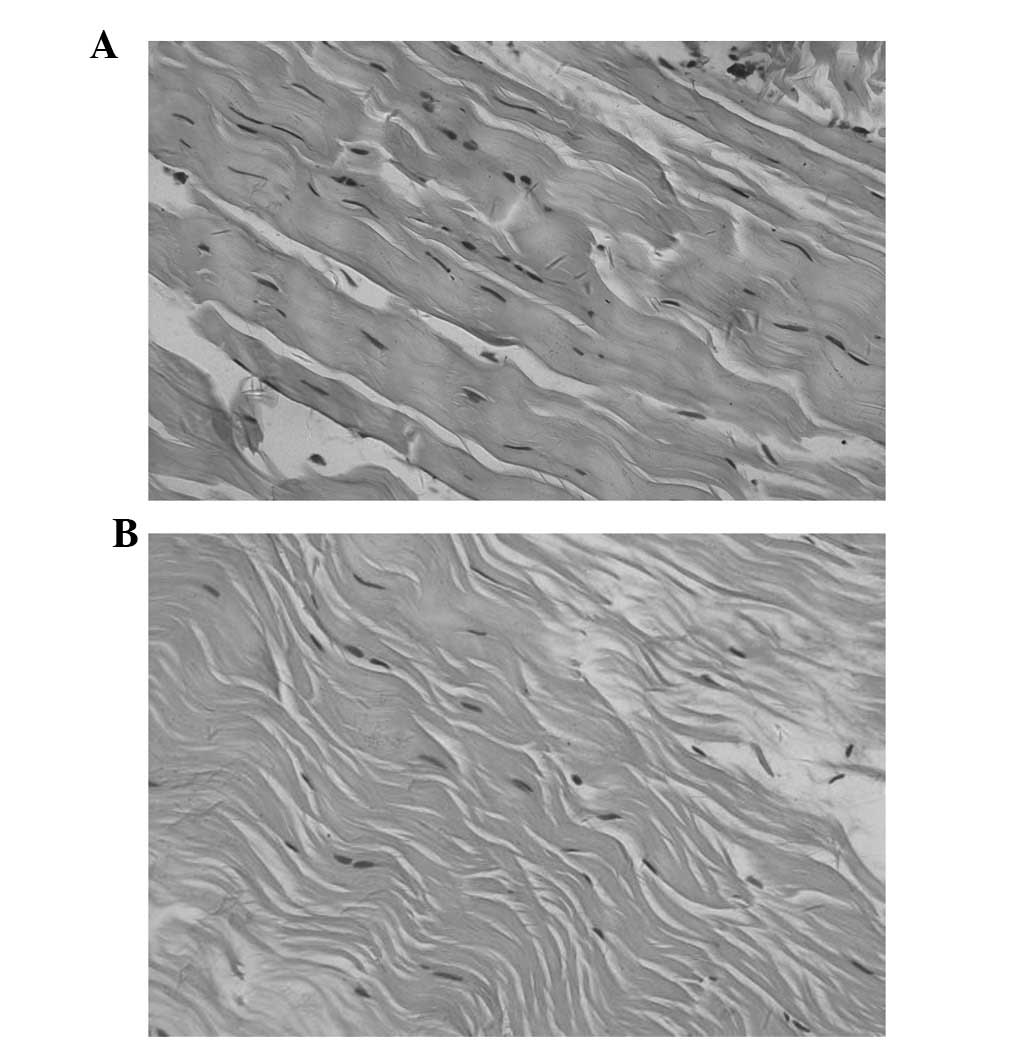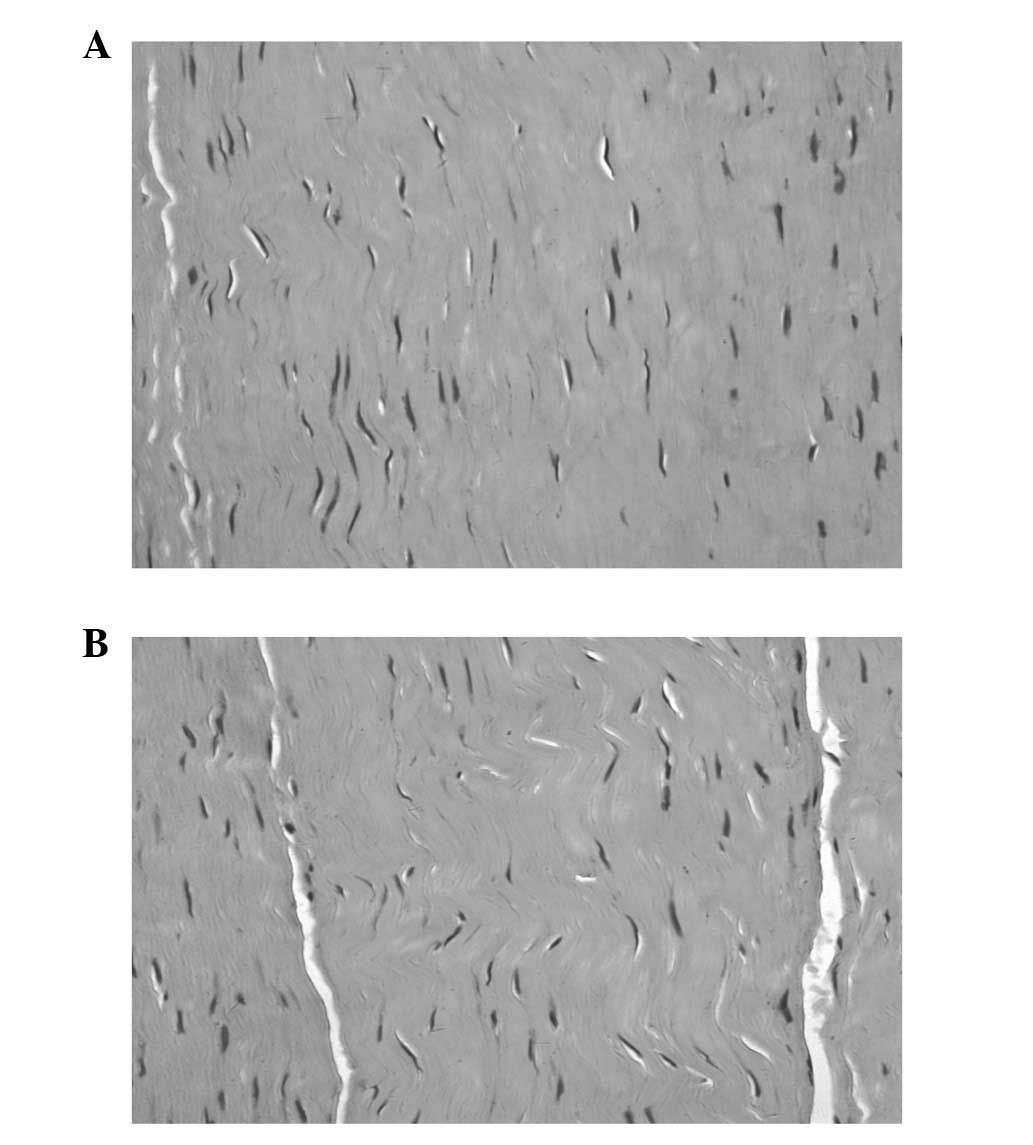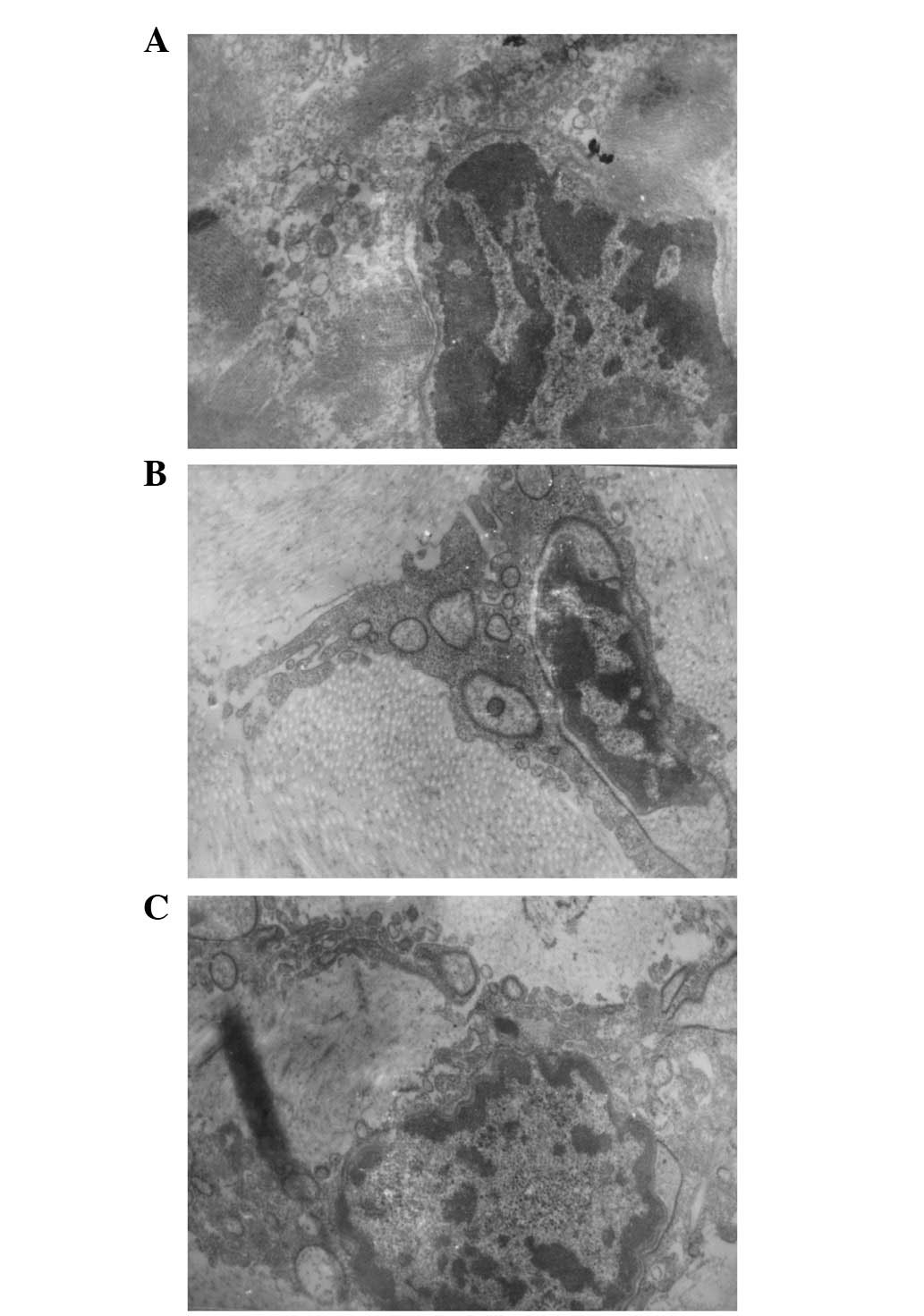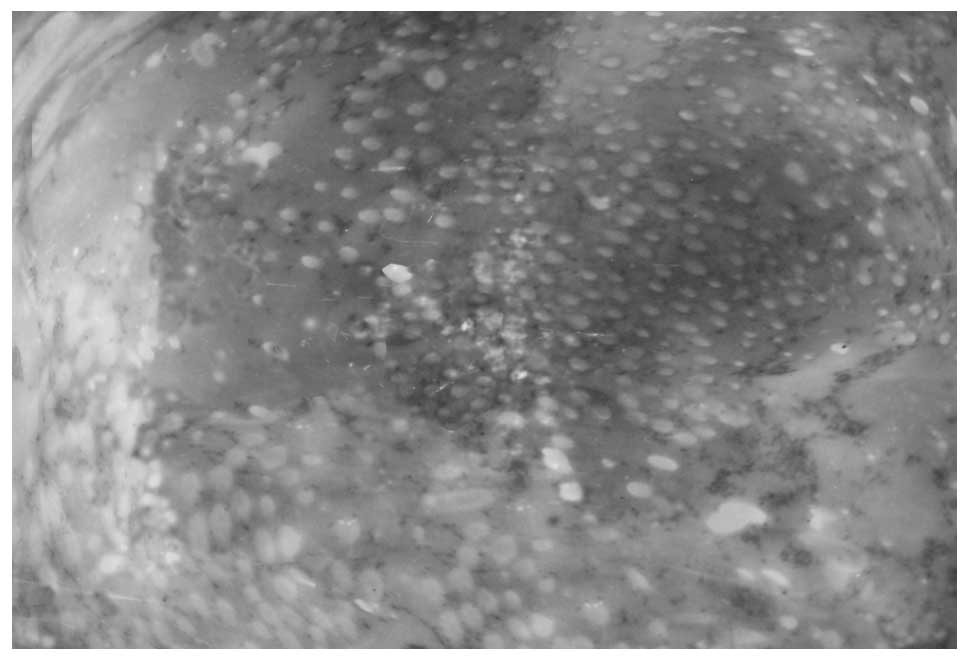Effects of gene‑activated matrix on autograft healing of anterior cruciate ligament
- Authors:
- Published online on: November 30, 2012 https://doi.org/10.3892/mmr.2012.1211
- Pages: 679-683
Abstract
Introduction
Anterior cruciate ligament reconstruction has been performed on autologous tendons for a long time, however, complete healing of the graft is difficult. Regardless of whether the graft is autologous or allogeneic, the healing process following reconstruction includes graft necrosis, cellular migration, revascularization and remodeling (1). Compared with the contralateral normal tendon, regenerated tendons contain less glycosaminoglycan and collagen. Regenerated tendons transmit the external force by the myotendinous junction, however, conduction velocities are slower than that of contralateral normal tendons and their maximum anti-drag force is 32% of that of contralateral normal tendons (2). Therefore, a new method of tendon reconstruction must be designed to ensure that regenerated tendons resemble the tissue structures and biomechanics of normal tendons more closely.
Materials and methods
Ethics
All study methods were approved by the ethics committee of the First People’s Hospital of Guangzhou (Guangzhou, China).
Animals and equipment
Forty-eight New Zealand adult white rabbits of either gender (age, 12 or 16 months old; weight, 2.0–3.0 kg) were provided by the Experimental Animal Center of Guangzhou Chinese Medical University (Guangzhou, China). The Olympus electron microscope was purchased from Shinjuku Monolith (Tokyo, Japan), the incubator was from Tai Site Test Equipment Co., Ltd. (Nanjing, China), the histotome was purchased from Cixi Yide Electronic Instrument Co. (Shenyang, China), the electric oven was provided by Xinghuo Electric Factory (Shanghai, China) and the water-heated incubator (220 V, 200–600°C) was obtained from Guoguang Medical Instrument Factory (Shanghai, China).
Grouping
The 48 New Zealand white rabbits were randomly divided into groups A and B (each group with 24 rabbits) and used as models of anterior cruciate ligament reconstruction. In group A, transforming growth factor (TGF)-β1 was locally injected into the bone tunnel, while in group B, empty vector was injected. Tendons were removed from 8 rabbits to observe the histology and ultrastructure and to evaluate biomechanics at postoperative months 1, 3 and 6 in the 2 groups.
Gene-activated matrix (GAM) preparation
GAM was prepared by mixing 6 μl liposomes (Invitrogen Life Technologies, Carlsbad, CA, USA) and 6 μg EGFP-N1-hTGF-β1 plasmids (Gene Institutes, Guangzhou, China) at room temperature and incubating for 15–30 min. Following this, the mixture was administered to group A. Liposomes (6 μl) and 6 μg EGFP-N1-hTGF (empty vector) was used in group B.
Surgical procedures
Rabbits were anesthetized by ear vein injection of 3% pentobarbital sodium (3 mg/kg) and placed in the supine position. With the patella as the centre, a 6-cm incision was made to expose the joint capsule. The joint capsule was opened and, following removal of the infrapatellar fat pad, the patella was raised to completely excise the anterior cruciate ligament. The semitendinosus insertion was exposed and retained. The proximal semitendinosus was separated and the myotendinous junction was cut. Interlacing suture was performed with silk suture in the free end of the semitendinosus to be used for tendon graft. The tibial tunnel was constructed with a 5-mm biopsy needle entering 5 mm above the semitendinosus insertion inside the tibial tubercle and exiting from the tibial plateau insertion of the anterior cruciate ligament. Similarly, the femoral tunnel was constructed entering from the fossa intercondylaris femoris of anterior cruciate ligament and exiting from the lateral condyle of the femur. The semitendinosus graft was passed through the tibial and femoral tunnels and fixed by suture with the knee lateral collateral ligament and surrounding soft tissue, performing anterior cruciate ligament reconstruction.
In group A, 2 mm3 GAM was locally injected into the bone tunnel with a 1-mm diameter needle, while in group B, 2 mm3 empty vector was injected.
The incision was closed and then the surgical limb was fixed in an extended position with a plaster cast. The plaster external fixation was removed 2 weeks later and the local conditions and limb activity were observed.
Histological observation of tendons
HE-stained tissue sections were generated to observe collagen fiber morphology, tendon cells, matrix content, the number of abnormal cells and fibrous bands.
The tissue samples were prepared for transmission electron microscopy by cutting the tendons into 5×4-mm tissue samples, fixing with 3% glutaral (0.2 M/l) for 2 h, washing with 0.2 M/l PBS 3 times every 15 min and fixing again with 1% osmic acid (0.2 M/l) for 2 h. The tissue underwent gradient dehydration with 30, 50, 70 and 90% alcohol, a mixture of 90% alcohol and 90% acetone and 90% acetone and 100% acetone, each time for 10–15 min. Dehydration was performed 3 times. Finally, the tissue was soaked in 100% acetone for 2 h, followed by slicing. Sections were stained with uranyl acetate for 10–15 min, washed with water 1–2 times, stained with lead nitrate for 10–15 min and washed with water. Cellular and nuclear ultrastructures were observed.
Biomechanical analysis of tendons
In the surgical limb, complete thigh and tarsal amputation were performed to retain the femur and tibia. With the exception of the anterior cruciate ligament, all other ligaments, skin, muscle and joint capsule of the knee joint were removed. The ends of the bone were fixed with 3-cm Kirschner wires and embedded in denture base resin for biomechanical analysis.
For biomechanical analysis, specimens were loaded into a MTS-858 biological material testing machine. There was a computer in front of the testing machine and data were produced as a direct readout by the computer. The decay rate was set at 1, the measuring range of sensor at 25 N and the loading speed at 10 mm/min. The testing machine was operated until tendons were broken and the maximum force, displacement of maximum load, the stress force, strain and elastic modulus were recorded.
Statistical analysis
Statistical analysis was performed using SPSS 12.0 software. Numerical data are presented as the mean ± SD. Homogeneity test for variance was used and significant values were analyzed further by t-tests. Measurement data are presented as constituent ratios (n%). A Chi-square test of 4-fold table was used in the comparison of the groups. When the theoretical frequency was <5, the Chi-square test correction formula was used. P<0.05 was considered to indicate a statistically significant difference.
Results
General conditions of transplanted tendons
Graft rupture occurred in one rabbit in group A at postoperative month 1. In group B, no graft rupture occurred. The overall success rate of grafts was 98.6%.
Gross observation on successfully transplanted tendons
Gross morphology was similar between the 2 groups.
Histological observation on transplanted tendons
Optical microscopy was used to observe the 4 morphological stages, including tissue necrosis, inflammatory infiltration, cell regeneration and tissue molding. In group B, a reduced number of fibroblasts and collagen fibers was observed at each time-point. In group A, there were more fibroblasts and collagen fibers and postoperative month 6 tissue structures were similar to normal tissue (Figs. 1 and 2).
At postoperative month 1, mainly reticular fibers were observed by electron microscopy, collagen fibers were reduced, liposomes and necrotic tissue were present, nuclear shrinkage, accumulation of abnormal chromatin and mitosis were noted and cellular proliferation was active. At postoperative month 3, collagen fibers were markedly increased and active mitosis and cell proliferation were present. Electron microscopy identified increased levels of mitosis and an abundance of cellular matrix, endoplasmic reticulum and mitochondria in group A at each time-point compared with B (Figs. 3 and 4).
Biomechanical results
No statistical difference in each biomechanical parameter between the 2 groups at postoperative month 1 was identified. However, at postoperative months 3 and 6, maximum force and elastic modulus were found to be significantly greater in group A than in B (P<0.0.5), however, other biochemical parameters were not identified to be significantly different between the 2 groups (Tables I–III).
Discussion
A variety of autologous tendon grafts are currently used to reconstruct the anterior cruciate ligament, however, complete graft-host healing is difficult and a number of severe complications, including relaxation and rupture of the autologous tendon graft, are associated with the proceedure.
TGF-β1 possesses a number of biological functions. The growth factor promotes the synthesis of I, III, V and VI type collagen and glycoproteins and improves the differentiation potential of mesenchymal stem cells into chondrocytes and osteocytes. TGF-β1 promotes tissue repair by increasing fibroblast and extracellular matrix synthesis and inhibiting the degradation of newly synthesized matrix (3). TGF-β1 increases angiopoiesis and induces fibroblast, monocyte and macrophage migration to sites of injury, promoting ligament healing. A previous study reported TGF-β1 expression in the rabbit anterior cruciate and medial collateral ligaments 10 days prior to healing (4), and local application of exogenous TGF-β1 has been hypothesized to increase ligamentous strength, stiffness and anti-drag force (5).
However, TGF-β1 possesses low bioavailability due to fast metabolism in vivo and immunogenicity which affects in vivo application (6). Gene plasmids store cytokines in vectors in DNA form, delivering a more stable cytokine with lower immunogenicity and higher expression. In traditional gene transfection techniques, host cells are removed and incubated in vitro, transfected with the target gene and then re-transplanted into the host. This method is complex, expensive and requires an unsuitable time-frame for repair of acute ligament injury.
In previous years, in situ tissue engineering has been researched and developed and has demonstrated promise for use in a number of acute injury repair procedures (7). In situ tissue engineering involves the combination of biological materials with DNA plasmids to develop a GAM gene delivery system. The GAM system is then transplanted into the defective tissue where endogenous cells enter the matrix and are transfected with the plasmids. The transfected cells secrete plasmid-encoded protein products functioning as local in vivo bio-reactors. This system is known as a local gene delivery carrier (8). In situ gene engineering is associated with a number of advantages, including simple procedures, high bioavailability and reduced immunogenicity.
The traditional viral vector possesses marked transfection efficiency. However, it is expensive and easy to trigger a severe immune response and is therefore difficult to use in clinical practice (9). Non-viral vectors include liposome and polymeric vectors and are considered cheap, simple, safe, biodegradable and slow-release. Previously, biomaterials, including collagen, hyaluronic acid, alginates, chitosan and polylactide-co-glycotide, have been used as vectors for repair of bone or cartilage defects. Promising results have been reported, however, limited studies have been performed on their use in ligament repair (10–13).
Ligament restoration following injury is mediated by a non-specific pathological process associated with filling and organization of granulation and fibrous tissue. At present, repaired ligaments take an extremely long time to return to the strength levels of normal ligaments due to decreased collagen and disorderly arrangement. A previous study demonstrated that cytokines increased type I and III collagen expression (mainly type I collagen) during the ligament repair process and strength associated with normal ligaments was obtained within a shorter healing period (14). Therefore, promoting collagen secretion is an effective means to improve the quality of ligament repair. However, in vitro proliferation of ligament cells is slow and cells reach quiescence following several passages due to ligament cell differentiation, rendering them unsuitable for in vitro culture as seed cells for tissue engineering (15).
Based on the non-specific pathological process of post-injury ligament, we hypothesized that local application of GAM to the interface of ligament graft and bone tunnel may be an important step in in situ tissue engineering. GAM grafts release TGF-β1 slowly and maintain higher levels of TGF-β1 in the local environment in vivo, enabling fibroblasts to enter the GAM within 3–4 weeks and secrete large quantities of type I and III collagen to promote healing of the ligament graft. In the present study, an increased number of fibroblasts and collagen fibers was identified by optical microscopy in group A at each time-point compared with B. Electron microscopy indicated increased levels of mitosis and an abundance of matrix, endoplasmic reticulum and mitochondria in group A at each time-point compared with B. Histological results indicate that the post-healing ligament graft transfected by TGF-β1 in situ represents a normal ligament more closely and demonstrates that TGF-β1 promotes cell proliferation, differentiation and synthesis of collagen, processes vital to ligament healing.
In the current study, the maximum force was observed as significantly greater in group A compared with B (P<0.0.5) at postoperative months 3 and 6, demonstrating the efficacy of in situ transfection.
In summary, results indicate that GAM promotes healing of rabbit anterior cruciate ligament grafts and provide a theoretical basis for GAM application in ligament repair.
Acknowledgements
The present study was supported by the Key Project of Medical Science of Guangzhou City (2009-ZDi-20) and the Science and Technology Project of Guangdong Province (2007B031001003).
References
|
Duthon VB, Messerli G and Menetrey J: Anterior cruciate ligament reconstruction: indications and techniques. Rev Med Suisse. 4:2744–2748. 2008.(In French). | |
|
Chen NC, Brand JC and Brown CH: Biomechanics of intratunnel anterior cruciate ligament graft fixation. Clin Sports Med. 26:695–714. 2007. View Article : Google Scholar : PubMed/NCBI | |
|
Sporn MB and Roberts AB: Peptide growth factors and inflammation, tissue repair and cancer. J Clin Invest. 78:329–332. 1986. View Article : Google Scholar : PubMed/NCBI | |
|
Lee J, Chamberlin TA, Schreck PJ, et al: In situ localization of growth factors during the early healing of knee ligaments. Trans Orthop Res Soc. 20:158–162. 1995. | |
|
Conti NA and Dahners LE: The effect of exogenous growth factors on the healing of ligaments. Trans Orthop Res Soc. 18:601993. | |
|
Shimomura T, Jia F, Niyibizi C and Woo SL: Antisense oligonucleotides reduce synthesis of procollagen alpha1 (V) chain in human patellar tendon fibroblasts: potential application in healing ligaments and tendons. Connect Tissue Res. 44:167–172. 2003. View Article : Google Scholar | |
|
Bonadio J: Tissue engineering via local gene delivery. Mol Med (Berl). 78:303–311. 2000. View Article : Google Scholar | |
|
Bonadio J: Tissue engineering via local gene delivery: update and future prospects for enhancing the technology. Adv Drug Deliv Rev. 44:185–194. 2000. View Article : Google Scholar : PubMed/NCBI | |
|
Evans CH and Robbins PT: Genetically augmented tissue engineering of the musculoskeletal system. Clin Orthop Relat Res. 367(Suppl): S410–S418. 1999. View Article : Google Scholar : PubMed/NCBI | |
|
Andree C, Voigt M, Wenger A, et al: Plasmid gene delivery to human keratinocytes through a fibrin-mediated transfection system. Tissue Eng. 7:757–766. 2001. View Article : Google Scholar : PubMed/NCBI | |
|
Anderson DG, Peng W, Akinc A, et al: A polymer library approach to suicide gene therapy for cancer. Proc Natl Acad Sci USA. 101:16028–16033. 2004. View Article : Google Scholar : PubMed/NCBI | |
|
Pascher A, Steinert AF, Palmer GD, et al: Enhanced repair of the anterior cruciate ligament by in situ gene transfer: evaluation in an in vitro model. Mol Ther. 10:327–336. 2004. View Article : Google Scholar : PubMed/NCBI | |
|
Geiger F, Bertram H, Berger I, et al: Vascular endothelial growth factor gene-activated matrix (VEGF165-GAM) enhances osteogenesis and angiogenesis in large segmental bone defect. J Bone Miner Res. 20:2028–2035. 2005. View Article : Google Scholar : PubMed/NCBI | |
|
Cappelli E, Taylor R, Cevasco M, et al: Involvement of XRCCI and DNA ligase III gene products in DNA base excision repair. J Biol Chem. 272:23970–23975. 1997. View Article : Google Scholar : PubMed/NCBI | |
|
Shea LD, Smiley E, Bonadio J and Mooney DJ: DNA delivery from polymer matrices for tissue engineering. Nat Biolechnol. 17:551–554. 1999. View Article : Google Scholar : PubMed/NCBI |













